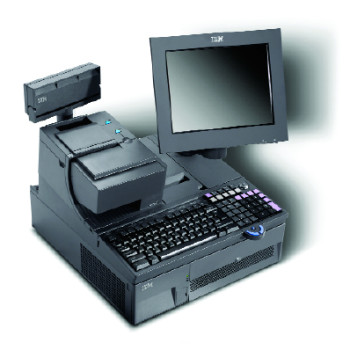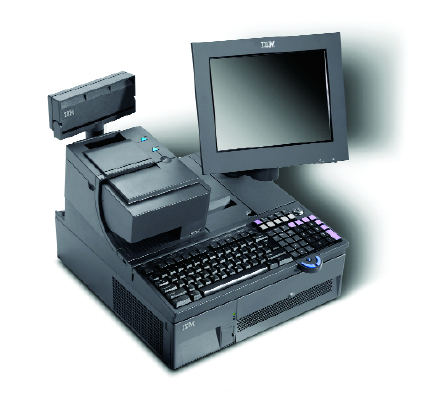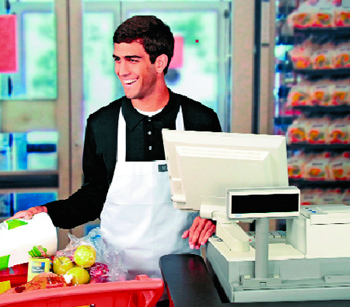Integrating information to increase profits

EPOS systems can now include a raft of integrated tools that allow retailers to do everything from tightening stock control to enhancing their security.
1 March 2008
According to the IHL Consulting Group, shipments of PC-based electronic point-of-sale (EPOS) equipment in the EMEA (Europe, Middle East, Africa) market increased by four per cent in 2006. Windows Embedded shipments, meanwhile, grew robustly, with WEPOS (Windows Embedded for Point of Service) and Windows XP Embedded shipments up 54 and 45 per cent respectively, according to the market research firm.
Security is becoming a major factor in POS purchase decisions, IHL noted. Retailers want POS systems that are "PCI" (Payment Card Industry) compliant, in order to avoid fraud and other security.
According to IHL Consulting Group president Greg Buzek, "Retailers continue to see the EPOS as more than just a method for accurately recording sales. Added functionality at the till, whether in the form of capabilities such as customer returns, inventory look-up, or workforce management, helps retailers see EPOS as THE central system in the store, and they are willing to invest in it accordingly."
INTEGRATION IS KEY
David MacHale of Forecourt Systems said the latest developments in its sector have been an integrated fuel-card and chip and pin solution developed for oil companies, dealers and their customers.

For most retailers EPOS represents a strategic business investment in technology that will not only improve the customer experience at the point of service, but will also help to manage the business into the future.
The whole system is integrated, and that reconciliation happens at the touch of a button. Integrated weighing scales have also been a development that has taken place on the back of forecourts incorporating delis and fresh food. A further development has come about in the integrated security systems within the EPOS.
MacHale believes the market trends in the forecourt area are two fold. Cash rich, time poor consumers are increasingly looking to forecourts to provide their food and groceries as well as petrol. Because of this, delis are increasingly becoming the norms in forecourt as are fresh groceries, leading to a demand in integrated weighing scales. “The other market trends are driven by legislation – prompts at the till e.g. with alcohol, asking the customer are they over eighteen so as to reduce litigation on shop owners are now a standard feature of our FuelPOS product. New environmental legislation means that vapour recovery will come into affect on forecourts – forecourt retailers must make sure that their EPOS will link directly to vapour recovery fitted pumps.”
MacHale’s advice to retailers thinking of taking the EPOS plunge is to look not just at the current solution, but future plans and the EPOS provider themselves. He said the retailer needs to look at the future plans of the EPOS provider, the number of sites the EPOS is installed upon, what new developments are happening with the system etc. “The retailer needs to make sure that the EPOS they are looking at is specifically designed for that area (e.g. newsagent, forecourt, off-license, supermarket). The other key factor is maintenance and service, where are the nearest service engineers, what are their quality standards, what kind of knowledge do the company have in your area.”
In the forecourt sector MacHale sees some changes on the way. His own company will be launching ‘pay at the pump’ for forecourt retailers. “It will have a huge impact on how retailers can pay for petrol securely and it will also allow them to buy a car wash at the pump. The system will be the first fully integrated outdoor payment terminal and EPOS available in Ireland and offers forecourt owners the chance to run express lanes, or unmanned stations at night time.”
Another innovative Forecourt Systems will be launching towards the end of the year will be ANPR for EPOS and CCTV. ANPR (automatic number plate recognition) will, the company claims, be available for the first time for Irish forecourt owners and will help them reduce drive-offs dramatically. The forecourt attendant will be able to disengage the fuel dispenser from a repeat offender or an offender on an existing database.
A CHANGING WORLD NEEDS CHANGING EPOS
Conn Loy of IOResource said EPOS is dynamic by its very nature, so the development and deployment of EPOS systems is dynamic and, as such, systems are subject to perpetual change, upgrade and further review.
As is the case with any business, retailers continuously seek to improve on their return on investment. For most retailers EPOS represents a strategic business investment in technology that will not only improve the customer experience at the point of service, but will also help to manage the business into the future. At a fundamental level an EPOS system is a business tool. The more powerful and versatile the system, the more sophisticated the tool available to the retailer.
Loy said system trends over the last number of years have been towards greater integration not just of back office systems, stock control, buying, and so on but also with security systems for article tag deactivation, CCTV systems, vending machines, top-ups, product lookup devices, customer loyalty and so on.
“The net result of this has been the near extinction of old style electronic cash registers in serious retail environments and despite the attempts by traditional cash register manufacturers to bridge the gap between electronic cash registers vs PC based EPOS systems by introducing pad type systems with touch panels as touch screen systems real EPoS systems from retail systems specialists such as J2 Retail Systems and innovators such as Elo TouchSystems now drive the market because they offer the retailer the kind of flexibility, power and future proofing that facilitates the secure and efficient running of their business into the future.”
Loy also noted that older EPOS systems were starting to creak under more modern demands. “The software was based on older file structures that now struggle to facilitate all of the extra ‘bits’ that have been bolted on as retailers have pushed their systems suppliers and integrators to provide solutions that are increasingly feature rich. Because of the need to provide more information, more integration and more diversification retail applications have had to be redeveloped using data structures that push existing hardware resources to their limits.
“The more progressive hardware manufacturers have responded by introducing systems with more powerful processors, higher base memory and which can be upgraded with ease using standard components.”
Loy believes one area in which retailers are expressing greater interest is self service. The idea has been around for a number of years with different solutions available ranging from scanners that are collected when the customer enters the store, which then scans each product as they put into the basket through to free standing self service kiosks. While this technology has been available to larger retailers for a number of years, small to medium size retailers are now seeking similar solutions that can be scaled to their individual requirements allowing them to reduce costs and improve customer service/through put.
“In a similar vein, customer information points are also gaining prominence. Retailers are seeking to reduce queues at customer service points by providing information at key locations around the store via simple price/product lookup devices such as the Shuttle SG-15 from Scantech-ID, with 58.8 per cent market share in EMEA the Shuttle features a build in barcode scanner and small screen that allows the consumer to scan the barcode and display the price and so on. More sophisticated devices can be used to display information on bottles of wine, recipes and nutritional information and so on. Even printing off information that the consumer can take away with them.”
FIRST AND SECOND GENERATION
According to Loy EPOS is also serving the customer well. “As a consumer, I believe that my own experience today is certainly vastly better than it was five or ten years ago. Service is quicker, more efficient and the range of options available to me at the point of service is more extensive and flexible.”
He also said the range of devices and options available to customers has increased multifold over the years, particularly the last five – customer loyalty, top-ups, vending options, self service and so on. “Can you imagine the reaction that you would have received had you stated to the average consumer – or for that matter retailer – back in the early 1980s that consumers would be processing their own purchases in-store without sales assistants or check out operators? Or that they could scan the barcode on the product and check the price, lookup nutritional information, wedding lists in department stores and so on.”
Loy advised retailers, when buying or upgrading an EPOS system that the features of the system will depend on the type of environment and the retailer’s experience.
He said first generation retailers, i.e. those embarking on their first retail venture and therefore first purchase, may opt for a simple till or pad system. “Generally this is due to a combination two factors, the first being a lack of information about the key differences between EPOS systems and cash registers and the second is financial constraints. Rather than regarding the system as a business tool, these new arrivals to retail regard the point of service in its most simple terms – as a means of taking payment and storing cash.”
By the time a retailer is ready to invest in their second generation or subsequent system(s) “they generally have a good deal more experience and a better understanding of not just their system requirements but of how they need to develop their business in order to meet their personal goals, compete into the future and optimise the management of their business. Total cost of ownership is also now a primary consideration”.
According to Loy, the introduction of some form of “electronic purse” into the Irish market, is one change coming down the line in the coming year. It’s effectively a small scale credit card with a low limit on it, used for small purchases; the idea is to reduce the requirement to carry small amounts of cash for minor sales. The technology is based on a form of RFID or proximity reader technology which means that you don’t have to swipe the card – just present it to the reader. “The big challenge will be porting the technology from North America where Chip & Pin is not a consideration to markets such as Ireland where Chip & Pin could render the solution irrelevant as one of the key features of this solution is its simple "present and go" method of deducting payment.”
REMOTE SUPPORT
Bill Phelan of Quest said integration is becoming a key factor with retailers driving sales through web applications and the increase in online buying. “Retailers are looking for systems which minimise their staffs’ time inputting information/sales and maximise their selling potential.”
Phlean said most of the trends point to retailers looking for an all in one solution, in other words they are looking for companies who understand the retailing trade. “From design and layout of a shop front to implementation and design of POS systems. This is what we offer our customers. As technology evolves, so too does the level of sophistication of requirements.
“Customers now want remote support, so their staff can see and understand new concepts quickly and easily. They want centralised sales structures so that core admin personnel can administer the accounts as opposed to sales staff.”

Retailers are looking for systems which minimise their staffs’ time inputting information/sales and maximise their selling potential
Phlean believes that the customer experience is improving through EPOS and pointed to loyalty cards, which are giving the customer extra value for their money and the retailer is benefiting from extra sales and customer awareness
Phelan warned merchants considering purchasing an EPOS system that many appear initially to be good value, but retailers must keep an eye on the future and ensure there are not costly add on products. “All our pricing is available on the website, so its very clear how much everything costs.”
Phelan said Quest is looking into an interesting possibility with EPOS in the coming year. “The major banks have traditionally had a strangle hold on merchant card services ,as its difficult to change service providers, Quest are exploring the possibilities of offering the retailer the ability to change providers very quickly, this would lead to increased competition and will drive the cost of these services down.”
SELF CHECKOUT IN C-STORES
Philip Bateson of Leaders Enterprises said market trends in EPOS centred around areas such as consolidation, deli requirements and on-line authorisation over broadband. He said multi store owners are now consolidating all administration and back office functions, such as pricing by store type and so on.
Most convenience stores now have a significant deli offering which amounts to a major part of their sales. Many retailers now have a dedicated POS terminal in the deli area. The need to maintain greater control over deli ingredients has meant that SAMforWin, Leaders retail back-office software, has had to be enhanced to provide this extra functionality.
Processing chip and pin transactions over broadband has led to much faster transaction times. Commidea (the card processing system) can now complete the online authorisation in three seconds over broadband where other systems are still taking eight to ten seconds over standard analogue lines.
Reporting on credit card transactions has also improved. Commidea’s web reporting module allows retailers to report on credit card transactions from any of their stores using the web.
Bateson believes the customer experience is improving citing many recent innovations from his own company which have enabled retailers to provide better customer service and faster transactions times. “Such innovations include OLA over broadband for faster credit card processing and more accurate price labels using mobile label printers as well as ESL. An integrated pump controller for forecourts also helps speed up fuel transactions as the cashier does not need to consult another terminal. Everything is present on the cashier’s POS screen.”
Bateson believes that it’s important that retailers speak to other merchants who are using the system if they are considering installing an EPOS configuration. “This will soon let them know if anything is missing or if there are any customer service issues. Retailers should also ensure that their system provider has full control over the software and are not reliant on a third party to make changes. Having to rely on another software company can often lead to long delays and can ultimately cost the retailer a lot of money if they don’t have the functionality they need.”
Bateson pointed to self-checkout as one of the most exciting EPOS developments in the retail industry and it should become more prevalent in Ireland over the next 12-18 months as retailers seek to improve customer service and solve the problem of high staff turnover. “Although self-checkout is now fairly common in many of the multiple supermarkets in the UK, it still remains to be seen if there is a place for it in the convenience sector.”
Pat Kelly of Merit Solutions said integration is the key going forward, this leads to less time spent by the retailer consolidating several systems, such as credit card, cigarette vending, phone top ups, CCTV, tank gauges , biometrics for security and staff log in, fobs for customer loyalty systems, mobile barcode printing, electronic shelf edge labels.
He also believes the customer experience is improving. “Feature product notes prompt the checkout operator to tell customer about special offers. Also, transactions are faster with pictorial PLUs and promotions are automatically applied at the checkout.”
Kelly advised merchants contemplating EPOS that long term plans and developments need to be taken into account. “A retailer must think about their needs now and in the future. Who decides what the EPOS providers develop, with Merit Solutions it’s developed by a retailer for a retailer! They must also look out for hardware and software issues, how they are handled and managed.” Kelly pointed to web based solutions as one to watch in 2008.
LOYALTY SCHEMES
Dominic Feeney of CBE said integration of EPOS with other applications continues to be important to retailers. Functionality such as integrated mobile top-ups and BillPay offer retailers the ability to provide better service to their customers more efficiently and having complete integration with their EPOS system counter space that would otherwise be cluttered with third terminals is freed up for more profitable purposes. Touch Screen EPOS systems continue to evolve and are now the de-facto standard for all new EPOS systems. “By utilising this technology the EPOS / cashier user interface is more intuitive thereby increasing cashier productivity and greatly reducing training costs, particularly in sectors such as convenience stores where there is a high percentage of cashiers who do not speak English as their first language.”
Feeney said retailers continue to demand “One-Stop-Shop” solutions so that they only deal with one supplier for all their support requirements. He said they require systems that be easily and quickly modified to meet changes in their market or legislative requirements. “They need accurate, consolidated, real-time information to enable them adapt to the ever changing market place. More and more retailers are implementing loyalty schemes over the last 12 months in an effort to reward customer loyalty and to offer differentiators in a more competitive market. Retailers continue to focus on managing their costs, increasing their productivity and improving the service they provide to their customers.”
In terms of changes, Feeney pointed to several exciting developments coming on-stream from CBE in 2008 including self check out for independent supermarkets / convenience stores that up to now have only been available to the very large multiples. According to Feeney, these will offer independent and franchise retailers improved productivity and customer service. “We also have a major breakthrough coming for newsagents to revolutionise the way returns are handled, we have a powerful Loyalty solution, we are now rolling out Integrated BillPay solutions which allow customers pay their bills at any convenience store / supermarket, thus increasing footfall. We have also released our powerful new Head Office system for retailers with multiple stores and we have an extremely sophisticated security product coming on stream.”



 Print
Print






Fans 0
Followers